Business Strategy: Analysis, Models, and Strategic Plan
VerifiedAdded on 2023/01/12
|17
|4774
|51
AI Summary
This document provides an in-depth analysis of business strategy, including macro environment analysis, Pestle analysis, Porter's Five Force model, SWOT analysis, and VRIO Analysis. It also discusses the strategic plan using Bowman's strategy clock. The case study focuses on Tesco, a British multinational groceries company.
Contribute Materials
Your contribution can guide someone’s learning journey. Share your
documents today.
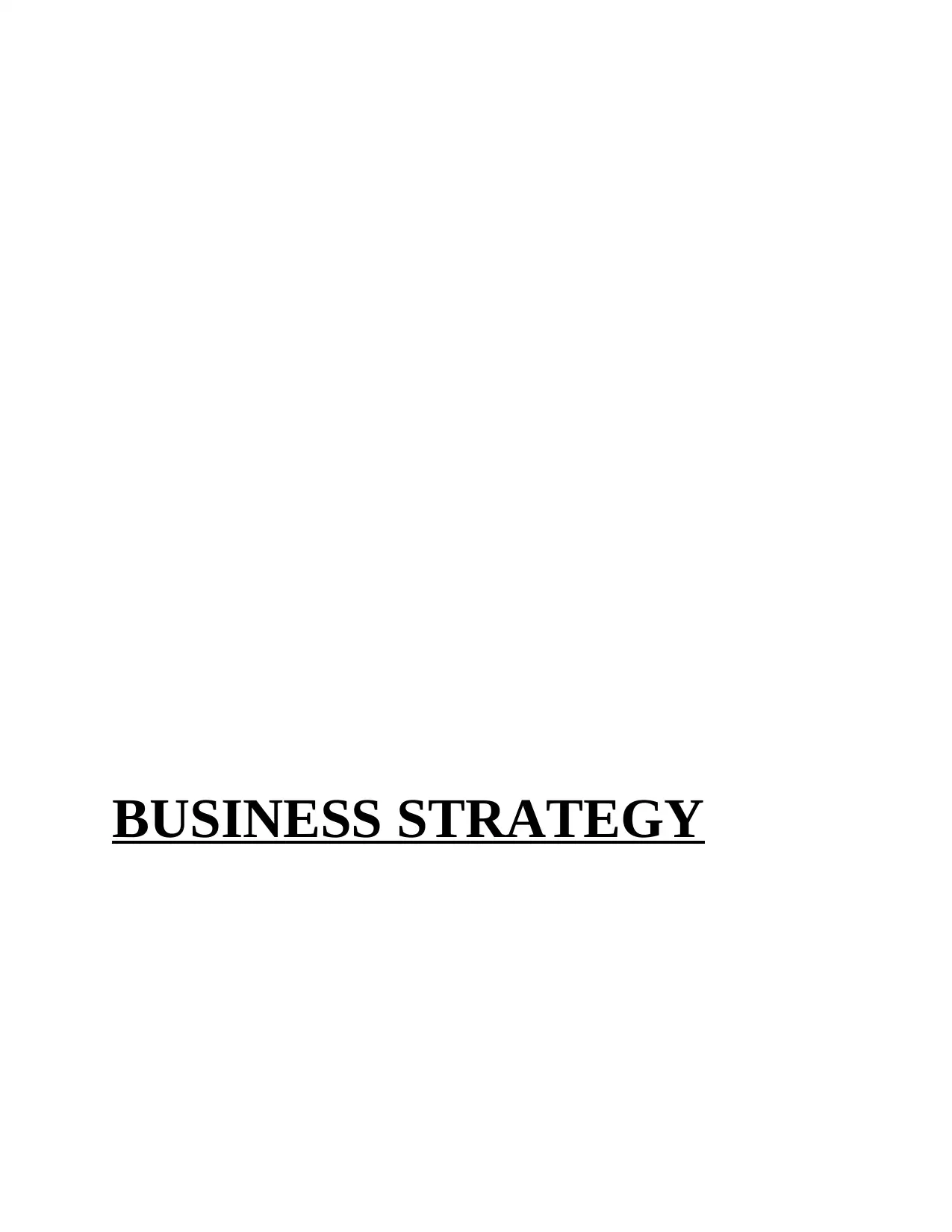
BUSINESS STRATEGY
Secure Best Marks with AI Grader
Need help grading? Try our AI Grader for instant feedback on your assignments.
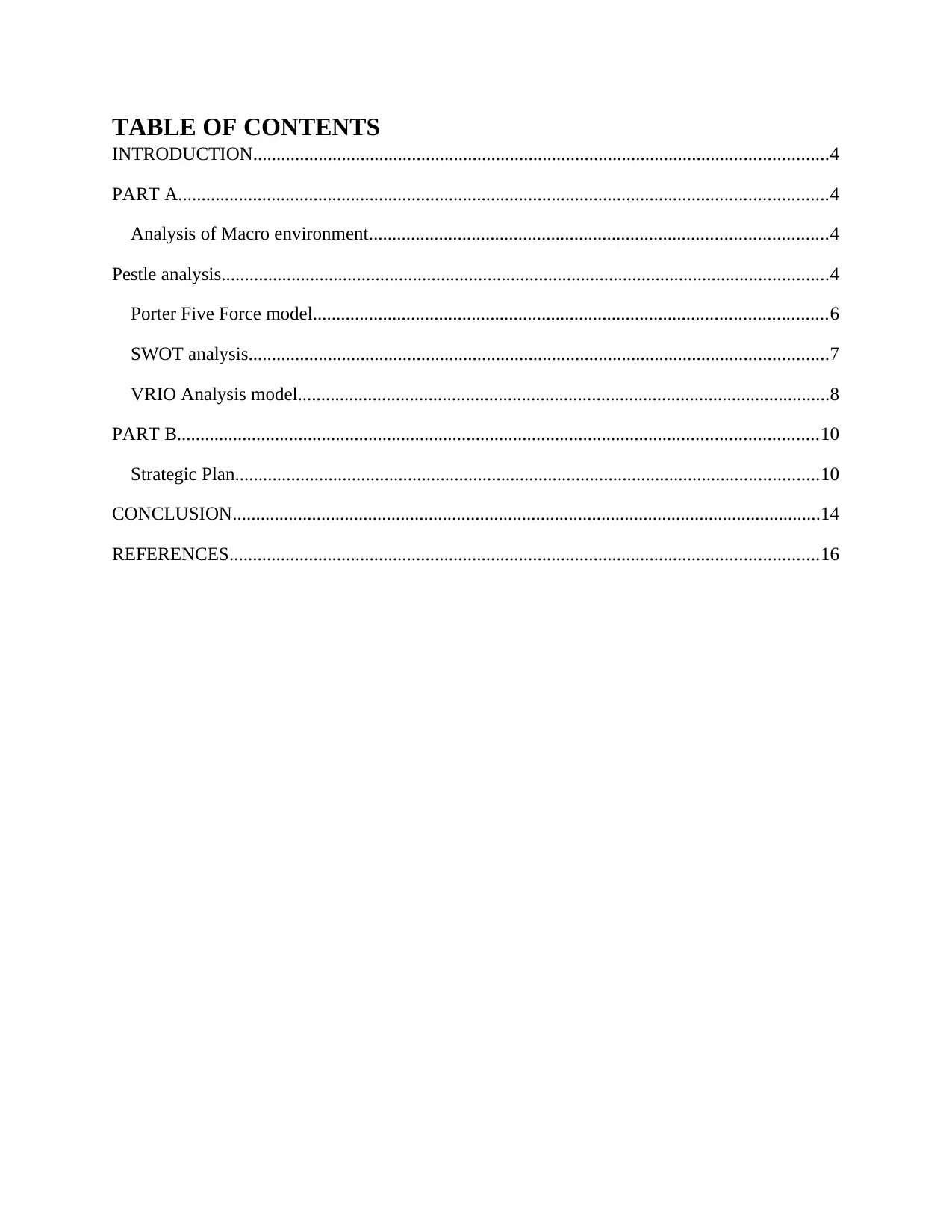
TABLE OF CONTENTS
INTRODUCTION...........................................................................................................................4
PART A...........................................................................................................................................4
Analysis of Macro environment..................................................................................................4
Pestle analysis..................................................................................................................................4
Porter Five Force model..............................................................................................................6
SWOT analysis............................................................................................................................7
VRIO Analysis model..................................................................................................................8
PART B.........................................................................................................................................10
Strategic Plan.............................................................................................................................10
CONCLUSION..............................................................................................................................14
REFERENCES..............................................................................................................................16
INTRODUCTION...........................................................................................................................4
PART A...........................................................................................................................................4
Analysis of Macro environment..................................................................................................4
Pestle analysis..................................................................................................................................4
Porter Five Force model..............................................................................................................6
SWOT analysis............................................................................................................................7
VRIO Analysis model..................................................................................................................8
PART B.........................................................................................................................................10
Strategic Plan.............................................................................................................................10
CONCLUSION..............................................................................................................................14
REFERENCES..............................................................................................................................16
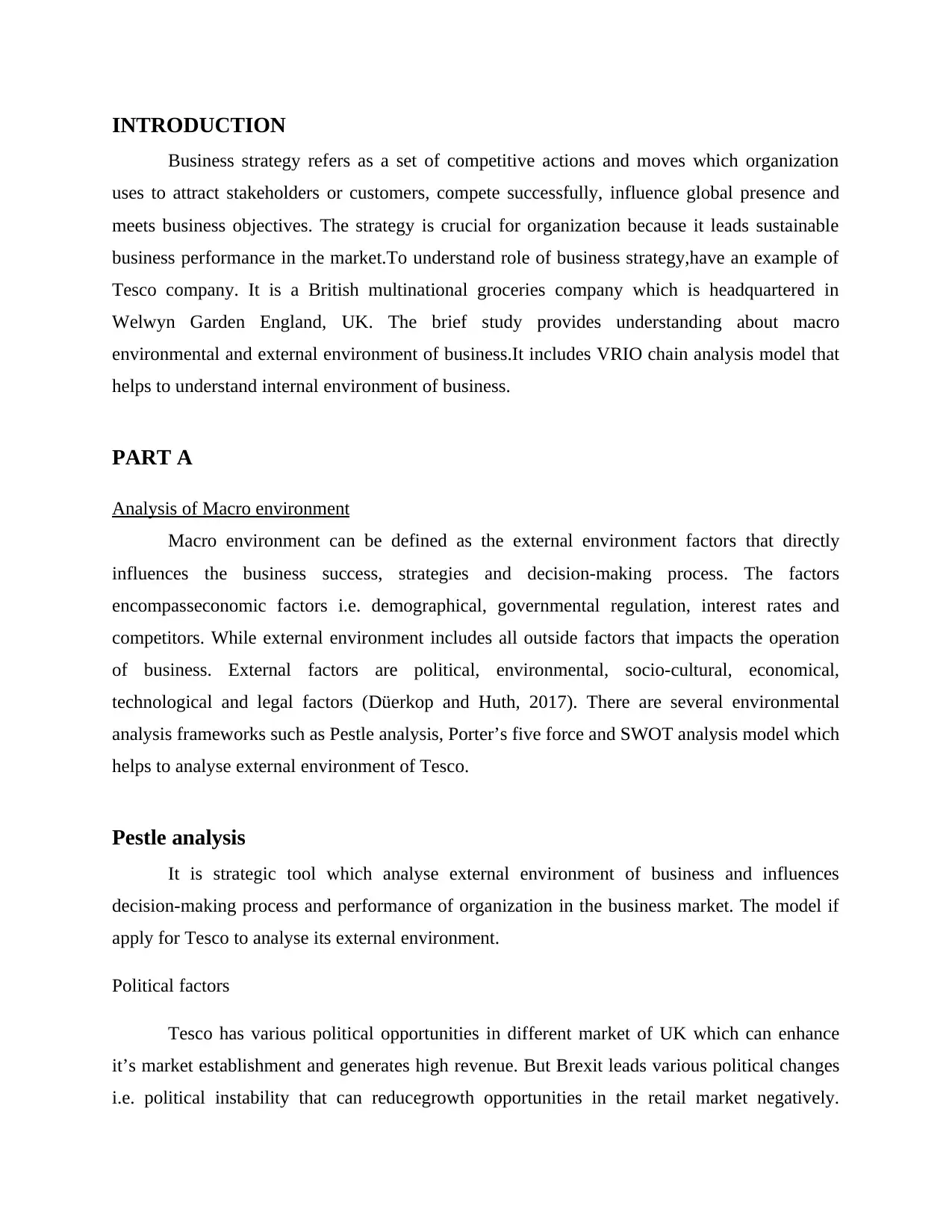
INTRODUCTION
Business strategy refers as a set of competitive actions and moves which organization
uses to attract stakeholders or customers, compete successfully, influence global presence and
meets business objectives. The strategy is crucial for organization because it leads sustainable
business performance in the market.To understand role of business strategy,have an example of
Tesco company. It is a British multinational groceries company which is headquartered in
Welwyn Garden England, UK. The brief study provides understanding about macro
environmental and external environment of business.It includes VRIO chain analysis model that
helps to understand internal environment of business.
PART A
Analysis of Macro environment
Macro environment can be defined as the external environment factors that directly
influences the business success, strategies and decision-making process. The factors
encompasseconomic factors i.e. demographical, governmental regulation, interest rates and
competitors. While external environment includes all outside factors that impacts the operation
of business. External factors are political, environmental, socio-cultural, economical,
technological and legal factors (Düerkop and Huth, 2017). There are several environmental
analysis frameworks such as Pestle analysis, Porter’s five force and SWOT analysis model which
helps to analyse external environment of Tesco.
Pestle analysis
It is strategic tool which analyse external environment of business and influences
decision-making process and performance of organization in the business market. The model if
apply for Tesco to analyse its external environment.
Political factors
Tesco has various political opportunities in different market of UK which can enhance
it’s market establishment and generates high revenue. But Brexit leads various political changes
i.e. political instability that can reducegrowth opportunities in the retail market negatively.
Business strategy refers as a set of competitive actions and moves which organization
uses to attract stakeholders or customers, compete successfully, influence global presence and
meets business objectives. The strategy is crucial for organization because it leads sustainable
business performance in the market.To understand role of business strategy,have an example of
Tesco company. It is a British multinational groceries company which is headquartered in
Welwyn Garden England, UK. The brief study provides understanding about macro
environmental and external environment of business.It includes VRIO chain analysis model that
helps to understand internal environment of business.
PART A
Analysis of Macro environment
Macro environment can be defined as the external environment factors that directly
influences the business success, strategies and decision-making process. The factors
encompasseconomic factors i.e. demographical, governmental regulation, interest rates and
competitors. While external environment includes all outside factors that impacts the operation
of business. External factors are political, environmental, socio-cultural, economical,
technological and legal factors (Düerkop and Huth, 2017). There are several environmental
analysis frameworks such as Pestle analysis, Porter’s five force and SWOT analysis model which
helps to analyse external environment of Tesco.
Pestle analysis
It is strategic tool which analyse external environment of business and influences
decision-making process and performance of organization in the business market. The model if
apply for Tesco to analyse its external environment.
Political factors
Tesco has various political opportunities in different market of UK which can enhance
it’s market establishment and generates high revenue. But Brexit leads various political changes
i.e. political instability that can reducegrowth opportunities in the retail market negatively.
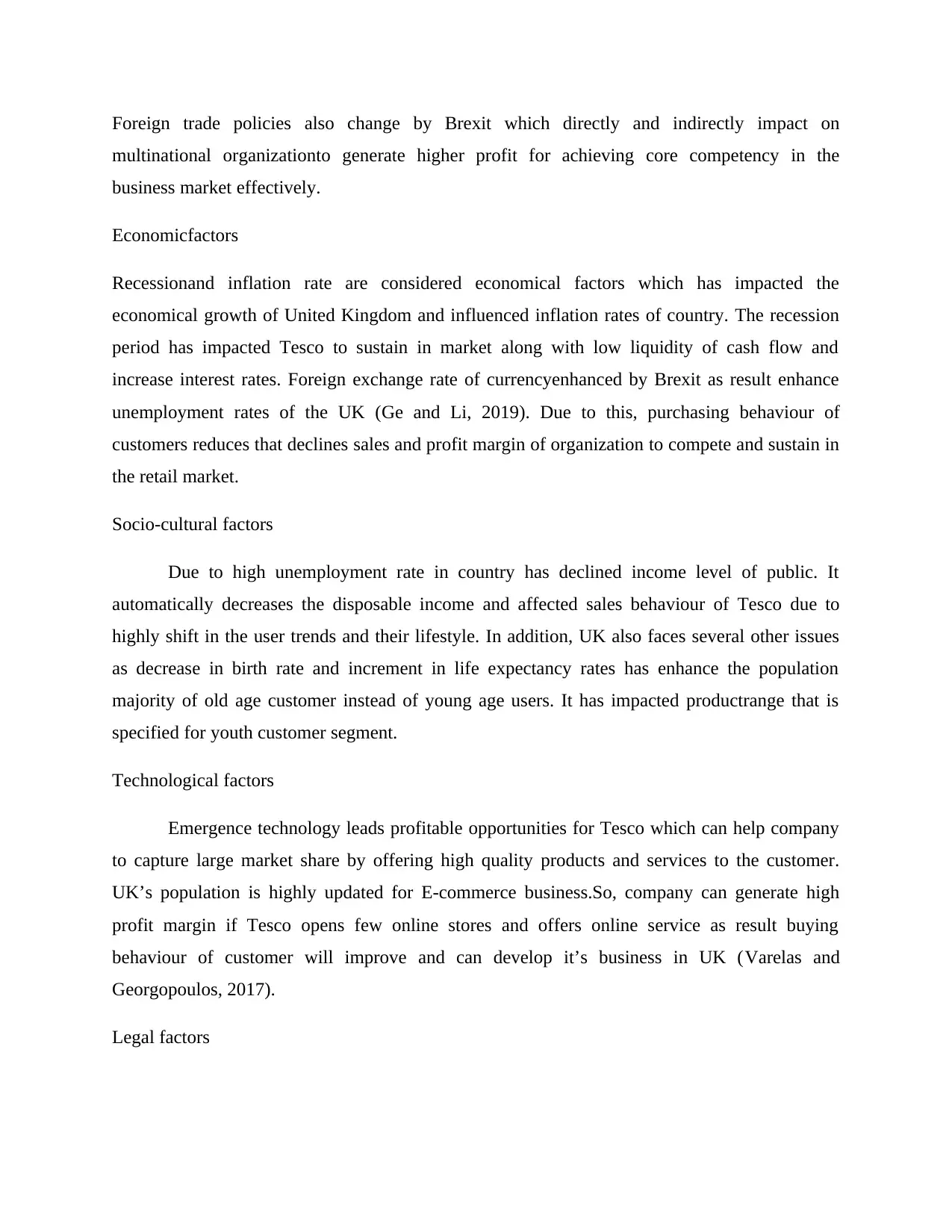
Foreign trade policies also change by Brexit which directly and indirectly impact on
multinational organizationto generate higher profit for achieving core competency in the
business market effectively.
Economicfactors
Recessionand inflation rate are considered economical factors which has impacted the
economical growth of United Kingdom and influenced inflation rates of country. The recession
period has impacted Tesco to sustain in market along with low liquidity of cash flow and
increase interest rates. Foreign exchange rate of currencyenhanced by Brexit as result enhance
unemployment rates of the UK (Ge and Li, 2019). Due to this, purchasing behaviour of
customers reduces that declines sales and profit margin of organization to compete and sustain in
the retail market.
Socio-cultural factors
Due to high unemployment rate in country has declined income level of public. It
automatically decreases the disposable income and affected sales behaviour of Tesco due to
highly shift in the user trends and their lifestyle. In addition, UK also faces several other issues
as decrease in birth rate and increment in life expectancy rates has enhance the population
majority of old age customer instead of young age users. It has impacted productrange that is
specified for youth customer segment.
Technological factors
Emergence technology leads profitable opportunities for Tesco which can help company
to capture large market share by offering high quality products and services to the customer.
UK’s population is highly updated for E-commerce business.So, company can generate high
profit margin if Tesco opens few online stores and offers online service as result buying
behaviour of customer will improve and can develop it’s business in UK (Varelas and
Georgopoulos, 2017).
Legal factors
multinational organizationto generate higher profit for achieving core competency in the
business market effectively.
Economicfactors
Recessionand inflation rate are considered economical factors which has impacted the
economical growth of United Kingdom and influenced inflation rates of country. The recession
period has impacted Tesco to sustain in market along with low liquidity of cash flow and
increase interest rates. Foreign exchange rate of currencyenhanced by Brexit as result enhance
unemployment rates of the UK (Ge and Li, 2019). Due to this, purchasing behaviour of
customers reduces that declines sales and profit margin of organization to compete and sustain in
the retail market.
Socio-cultural factors
Due to high unemployment rate in country has declined income level of public. It
automatically decreases the disposable income and affected sales behaviour of Tesco due to
highly shift in the user trends and their lifestyle. In addition, UK also faces several other issues
as decrease in birth rate and increment in life expectancy rates has enhance the population
majority of old age customer instead of young age users. It has impacted productrange that is
specified for youth customer segment.
Technological factors
Emergence technology leads profitable opportunities for Tesco which can help company
to capture large market share by offering high quality products and services to the customer.
UK’s population is highly updated for E-commerce business.So, company can generate high
profit margin if Tesco opens few online stores and offers online service as result buying
behaviour of customer will improve and can develop it’s business in UK (Varelas and
Georgopoulos, 2017).
Legal factors
Secure Best Marks with AI Grader
Need help grading? Try our AI Grader for instant feedback on your assignments.
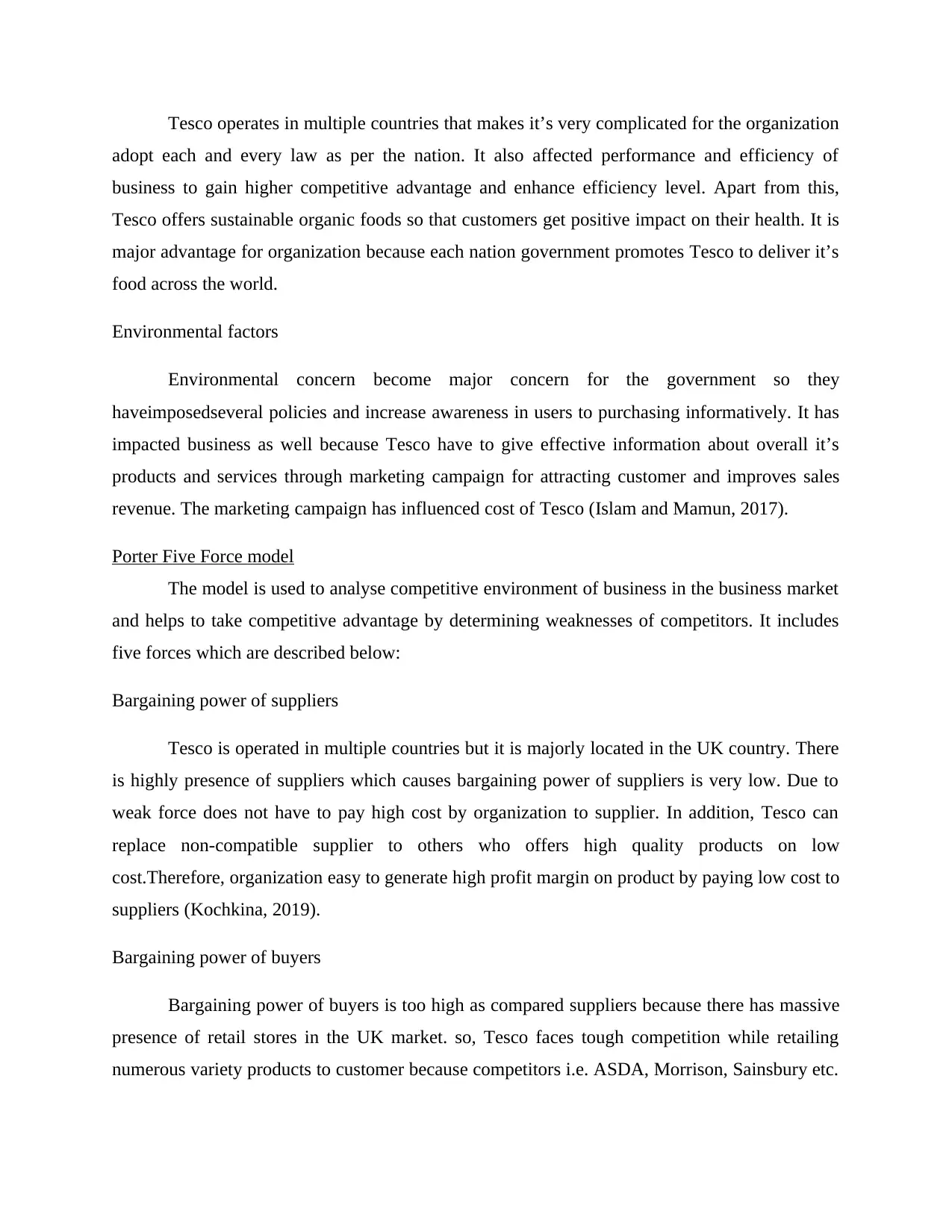
Tesco operates in multiple countries that makes it’s very complicated for the organization
adopt each and every law as per the nation. It also affected performance and efficiency of
business to gain higher competitive advantage and enhance efficiency level. Apart from this,
Tesco offers sustainable organic foods so that customers get positive impact on their health. It is
major advantage for organization because each nation government promotes Tesco to deliver it’s
food across the world.
Environmental factors
Environmental concern become major concern for the government so they
haveimposedseveral policies and increase awareness in users to purchasing informatively. It has
impacted business as well because Tesco have to give effective information about overall it’s
products and services through marketing campaign for attracting customer and improves sales
revenue. The marketing campaign has influenced cost of Tesco (Islam and Mamun, 2017).
Porter Five Force model
The model is used to analyse competitive environment of business in the business market
and helps to take competitive advantage by determining weaknesses of competitors. It includes
five forces which are described below:
Bargaining power of suppliers
Tesco is operated in multiple countries but it is majorly located in the UK country. There
is highly presence of suppliers which causes bargaining power of suppliers is very low. Due to
weak force does not have to pay high cost by organization to supplier. In addition, Tesco can
replace non-compatible supplier to others who offers high quality products on low
cost.Therefore, organization easy to generate high profit margin on product by paying low cost to
suppliers (Kochkina, 2019).
Bargaining power of buyers
Bargaining power of buyers is too high as compared suppliers because there has massive
presence of retail stores in the UK market. so, Tesco faces tough competition while retailing
numerous variety products to customer because competitors i.e. ASDA, Morrison, Sainsbury etc.
adopt each and every law as per the nation. It also affected performance and efficiency of
business to gain higher competitive advantage and enhance efficiency level. Apart from this,
Tesco offers sustainable organic foods so that customers get positive impact on their health. It is
major advantage for organization because each nation government promotes Tesco to deliver it’s
food across the world.
Environmental factors
Environmental concern become major concern for the government so they
haveimposedseveral policies and increase awareness in users to purchasing informatively. It has
impacted business as well because Tesco have to give effective information about overall it’s
products and services through marketing campaign for attracting customer and improves sales
revenue. The marketing campaign has influenced cost of Tesco (Islam and Mamun, 2017).
Porter Five Force model
The model is used to analyse competitive environment of business in the business market
and helps to take competitive advantage by determining weaknesses of competitors. It includes
five forces which are described below:
Bargaining power of suppliers
Tesco is operated in multiple countries but it is majorly located in the UK country. There
is highly presence of suppliers which causes bargaining power of suppliers is very low. Due to
weak force does not have to pay high cost by organization to supplier. In addition, Tesco can
replace non-compatible supplier to others who offers high quality products on low
cost.Therefore, organization easy to generate high profit margin on product by paying low cost to
suppliers (Kochkina, 2019).
Bargaining power of buyers
Bargaining power of buyers is too high as compared suppliers because there has massive
presence of retail stores in the UK market. so, Tesco faces tough competition while retailing
numerous variety products to customer because competitors i.e. ASDA, Morrison, Sainsbury etc.
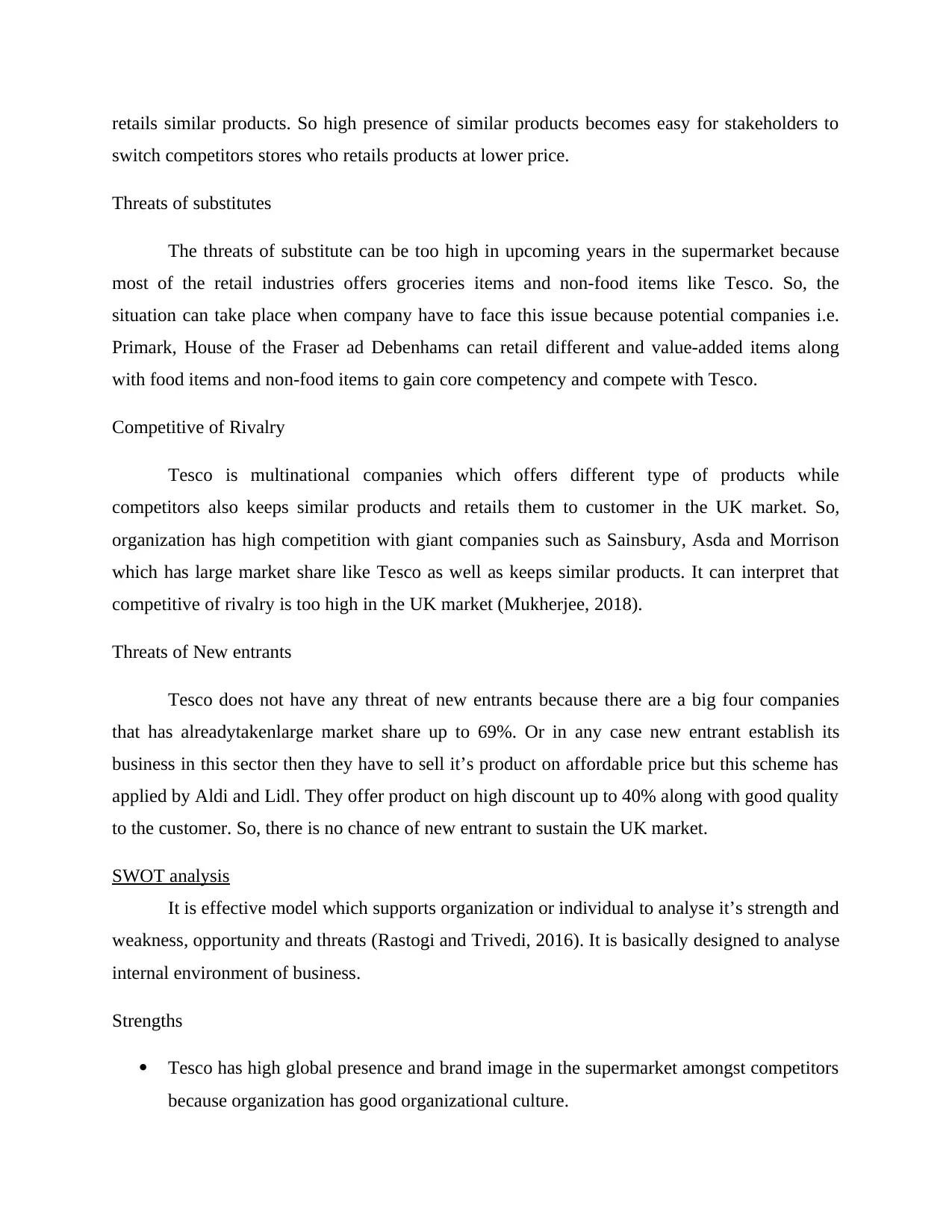
retails similar products. So high presence of similar products becomes easy for stakeholders to
switch competitors stores who retails products at lower price.
Threats of substitutes
The threats of substitute can be too high in upcoming years in the supermarket because
most of the retail industries offers groceries items and non-food items like Tesco. So, the
situation can take place when company have to face this issue because potential companies i.e.
Primark, House of the Fraser ad Debenhams can retail different and value-added items along
with food items and non-food items to gain core competency and compete with Tesco.
Competitive of Rivalry
Tesco is multinational companies which offers different type of products while
competitors also keeps similar products and retails them to customer in the UK market. So,
organization has high competition with giant companies such as Sainsbury, Asda and Morrison
which has large market share like Tesco as well as keeps similar products. It can interpret that
competitive of rivalry is too high in the UK market (Mukherjee, 2018).
Threats of New entrants
Tesco does not have any threat of new entrants because there are a big four companies
that has alreadytakenlarge market share up to 69%. Or in any case new entrant establish its
business in this sector then they have to sell it’s product on affordable price but this scheme has
applied by Aldi and Lidl. They offer product on high discount up to 40% along with good quality
to the customer. So, there is no chance of new entrant to sustain the UK market.
SWOT analysis
It is effective model which supports organization or individual to analyse it’s strength and
weakness, opportunity and threats (Rastogi and Trivedi, 2016). It is basically designed to analyse
internal environment of business.
Strengths
Tesco has high global presence and brand image in the supermarket amongst competitors
because organization has good organizational culture.
switch competitors stores who retails products at lower price.
Threats of substitutes
The threats of substitute can be too high in upcoming years in the supermarket because
most of the retail industries offers groceries items and non-food items like Tesco. So, the
situation can take place when company have to face this issue because potential companies i.e.
Primark, House of the Fraser ad Debenhams can retail different and value-added items along
with food items and non-food items to gain core competency and compete with Tesco.
Competitive of Rivalry
Tesco is multinational companies which offers different type of products while
competitors also keeps similar products and retails them to customer in the UK market. So,
organization has high competition with giant companies such as Sainsbury, Asda and Morrison
which has large market share like Tesco as well as keeps similar products. It can interpret that
competitive of rivalry is too high in the UK market (Mukherjee, 2018).
Threats of New entrants
Tesco does not have any threat of new entrants because there are a big four companies
that has alreadytakenlarge market share up to 69%. Or in any case new entrant establish its
business in this sector then they have to sell it’s product on affordable price but this scheme has
applied by Aldi and Lidl. They offer product on high discount up to 40% along with good quality
to the customer. So, there is no chance of new entrant to sustain the UK market.
SWOT analysis
It is effective model which supports organization or individual to analyse it’s strength and
weakness, opportunity and threats (Rastogi and Trivedi, 2016). It is basically designed to analyse
internal environment of business.
Strengths
Tesco has high global presence and brand image in the supermarket amongst competitors
because organization has good organizational culture.
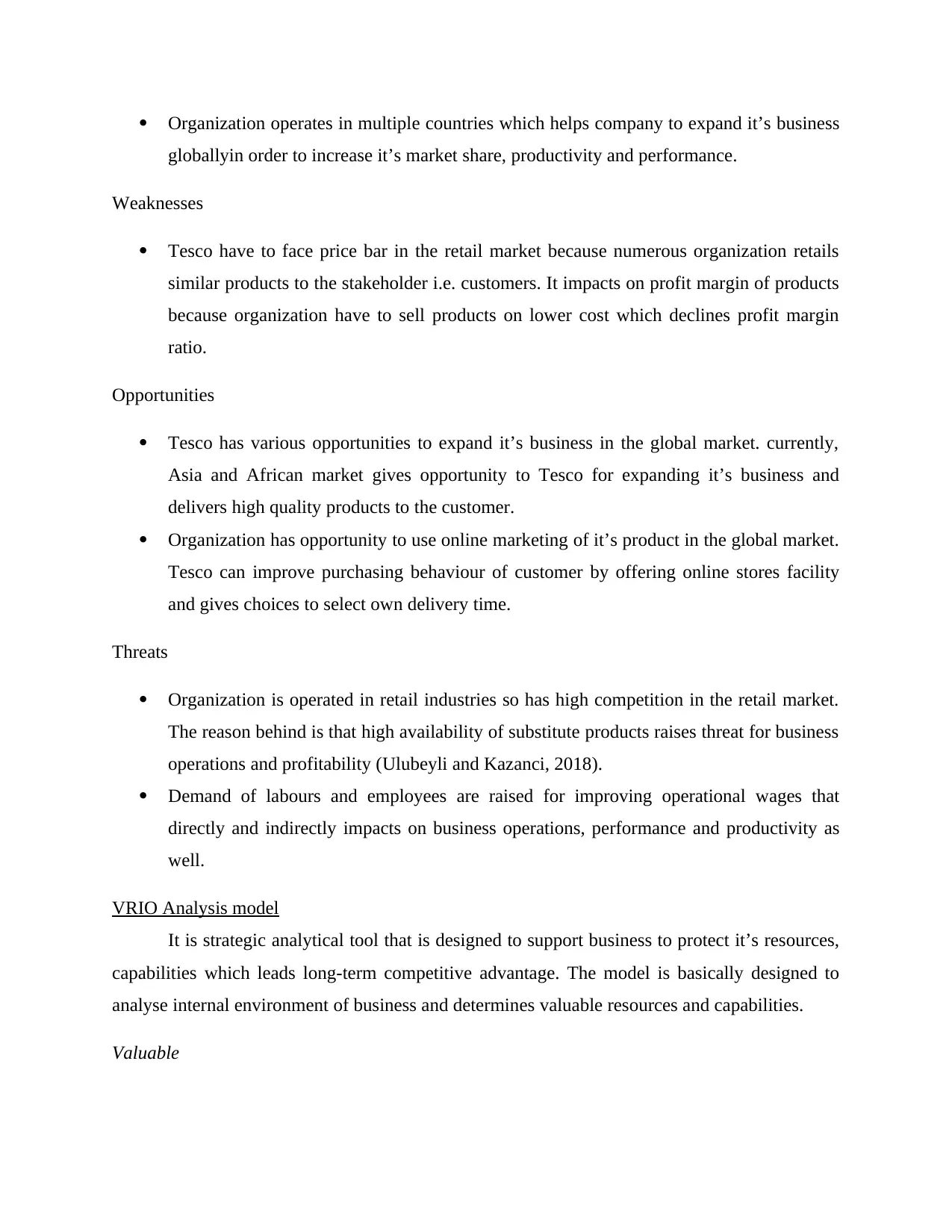
Organization operates in multiple countries which helps company to expand it’s business
globallyin order to increase it’s market share, productivity and performance.
Weaknesses
Tesco have to face price bar in the retail market because numerous organization retails
similar products to the stakeholder i.e. customers. It impacts on profit margin of products
because organization have to sell products on lower cost which declines profit margin
ratio.
Opportunities
Tesco has various opportunities to expand it’s business in the global market. currently,
Asia and African market gives opportunity to Tesco for expanding it’s business and
delivers high quality products to the customer.
Organization has opportunity to use online marketing of it’s product in the global market.
Tesco can improve purchasing behaviour of customer by offering online stores facility
and gives choices to select own delivery time.
Threats
Organization is operated in retail industries so has high competition in the retail market.
The reason behind is that high availability of substitute products raises threat for business
operations and profitability (Ulubeyli and Kazanci, 2018).
Demand of labours and employees are raised for improving operational wages that
directly and indirectly impacts on business operations, performance and productivity as
well.
VRIO Analysis model
It is strategic analytical tool that is designed to support business to protect it’s resources,
capabilities which leads long-term competitive advantage. The model is basically designed to
analyse internal environment of business and determines valuable resources and capabilities.
Valuable
globallyin order to increase it’s market share, productivity and performance.
Weaknesses
Tesco have to face price bar in the retail market because numerous organization retails
similar products to the stakeholder i.e. customers. It impacts on profit margin of products
because organization have to sell products on lower cost which declines profit margin
ratio.
Opportunities
Tesco has various opportunities to expand it’s business in the global market. currently,
Asia and African market gives opportunity to Tesco for expanding it’s business and
delivers high quality products to the customer.
Organization has opportunity to use online marketing of it’s product in the global market.
Tesco can improve purchasing behaviour of customer by offering online stores facility
and gives choices to select own delivery time.
Threats
Organization is operated in retail industries so has high competition in the retail market.
The reason behind is that high availability of substitute products raises threat for business
operations and profitability (Ulubeyli and Kazanci, 2018).
Demand of labours and employees are raised for improving operational wages that
directly and indirectly impacts on business operations, performance and productivity as
well.
VRIO Analysis model
It is strategic analytical tool that is designed to support business to protect it’s resources,
capabilities which leads long-term competitive advantage. The model is basically designed to
analyse internal environment of business and determines valuable resources and capabilities.
Valuable
Paraphrase This Document
Need a fresh take? Get an instant paraphrase of this document with our AI Paraphraser
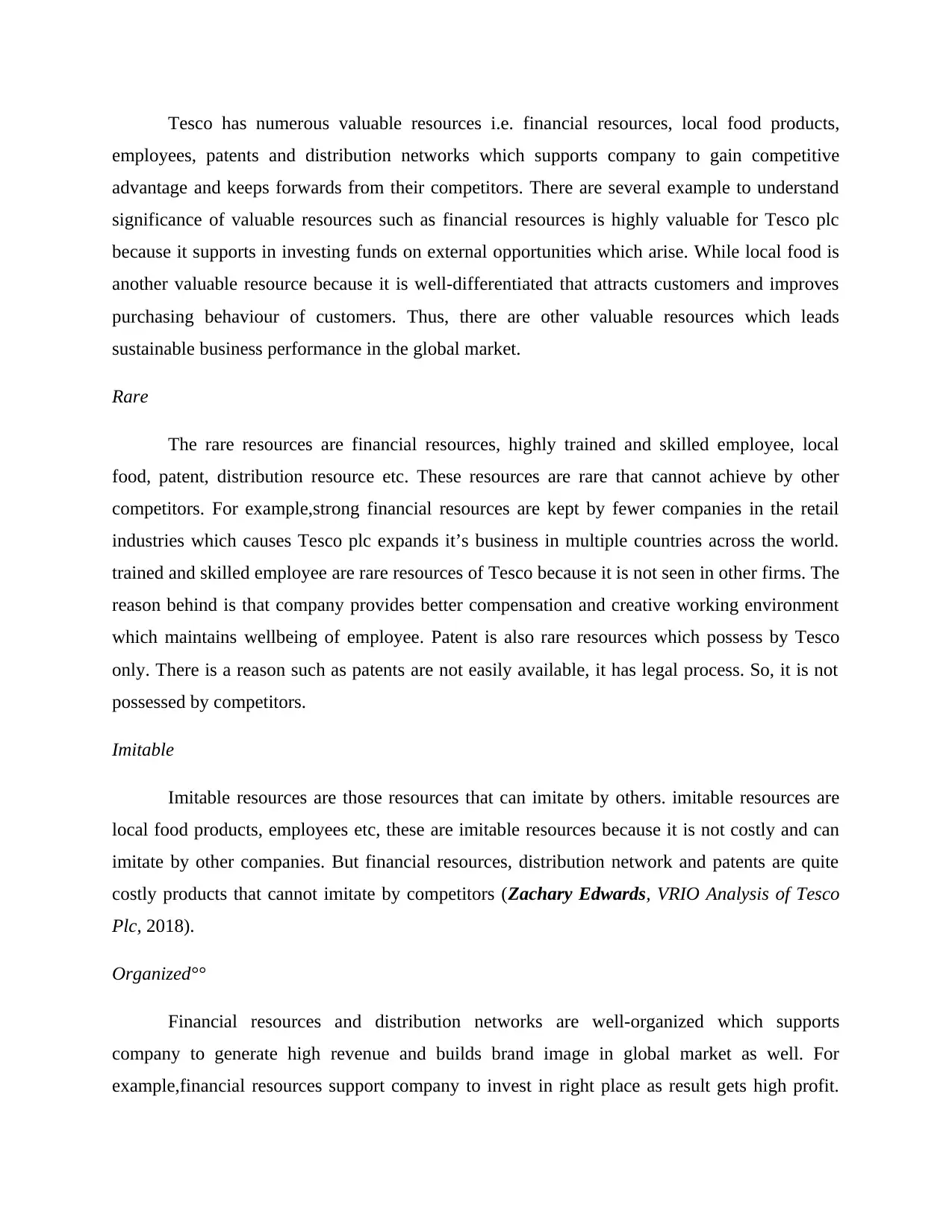
Tesco has numerous valuable resources i.e. financial resources, local food products,
employees, patents and distribution networks which supports company to gain competitive
advantage and keeps forwards from their competitors. There are several example to understand
significance of valuable resources such as financial resources is highly valuable for Tesco plc
because it supports in investing funds on external opportunities which arise. While local food is
another valuable resource because it is well-differentiated that attracts customers and improves
purchasing behaviour of customers. Thus, there are other valuable resources which leads
sustainable business performance in the global market.
Rare
The rare resources are financial resources, highly trained and skilled employee, local
food, patent, distribution resource etc. These resources are rare that cannot achieve by other
competitors. For example,strong financial resources are kept by fewer companies in the retail
industries which causes Tesco plc expands it’s business in multiple countries across the world.
trained and skilled employee are rare resources of Tesco because it is not seen in other firms. The
reason behind is that company provides better compensation and creative working environment
which maintains wellbeing of employee. Patent is also rare resources which possess by Tesco
only. There is a reason such as patents are not easily available, it has legal process. So, it is not
possessed by competitors.
Imitable
Imitable resources are those resources that can imitate by others. imitable resources are
local food products, employees etc, these are imitable resources because it is not costly and can
imitate by other companies. But financial resources, distribution network and patents are quite
costly products that cannot imitate by competitors (Zachary Edwards, VRIO Analysis of Tesco
Plc, 2018).
Organized°°
Financial resources and distribution networks are well-organized which supports
company to generate high revenue and builds brand image in global market as well. For
example,financial resources support company to invest in right place as result gets high profit.
employees, patents and distribution networks which supports company to gain competitive
advantage and keeps forwards from their competitors. There are several example to understand
significance of valuable resources such as financial resources is highly valuable for Tesco plc
because it supports in investing funds on external opportunities which arise. While local food is
another valuable resource because it is well-differentiated that attracts customers and improves
purchasing behaviour of customers. Thus, there are other valuable resources which leads
sustainable business performance in the global market.
Rare
The rare resources are financial resources, highly trained and skilled employee, local
food, patent, distribution resource etc. These resources are rare that cannot achieve by other
competitors. For example,strong financial resources are kept by fewer companies in the retail
industries which causes Tesco plc expands it’s business in multiple countries across the world.
trained and skilled employee are rare resources of Tesco because it is not seen in other firms. The
reason behind is that company provides better compensation and creative working environment
which maintains wellbeing of employee. Patent is also rare resources which possess by Tesco
only. There is a reason such as patents are not easily available, it has legal process. So, it is not
possessed by competitors.
Imitable
Imitable resources are those resources that can imitate by others. imitable resources are
local food products, employees etc, these are imitable resources because it is not costly and can
imitate by other companies. But financial resources, distribution network and patents are quite
costly products that cannot imitate by competitors (Zachary Edwards, VRIO Analysis of Tesco
Plc, 2018).
Organized°°
Financial resources and distribution networks are well-organized which supports
company to generate high revenue and builds brand image in global market as well. For
example,financial resources support company to invest in right place as result gets high profit.
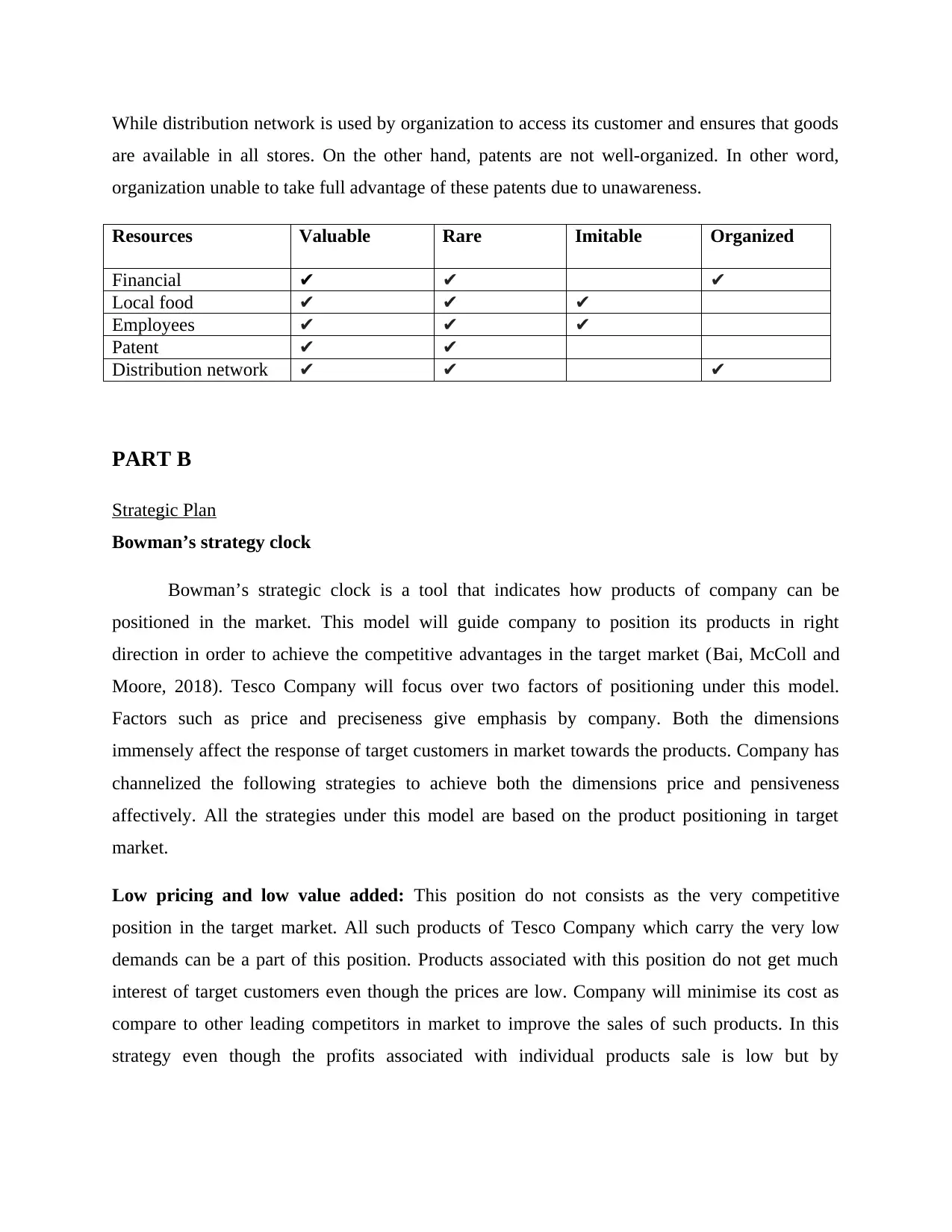
While distribution network is used by organization to access its customer and ensures that goods
are available in all stores. On the other hand, patents are not well-organized. In other word,
organization unable to take full advantage of these patents due to unawareness.
Resources Valuable Rare Imitable Organized
Financial ✔ ✔ ✔
Local food ✔ ✔ ✔
Employees ✔ ✔ ✔
Patent ✔ ✔
Distribution network ✔ ✔ ✔
PART B
Strategic Plan
Bowman’s strategy clock
Bowman’s strategic clock is a tool that indicates how products of company can be
positioned in the market. This model will guide company to position its products in right
direction in order to achieve the competitive advantages in the target market (Bai, McColl and
Moore, 2018). Tesco Company will focus over two factors of positioning under this model.
Factors such as price and preciseness give emphasis by company. Both the dimensions
immensely affect the response of target customers in market towards the products. Company has
channelized the following strategies to achieve both the dimensions price and pensiveness
affectively. All the strategies under this model are based on the product positioning in target
market.
Low pricing and low value added: This position do not consists as the very competitive
position in the target market. All such products of Tesco Company which carry the very low
demands can be a part of this position. Products associated with this position do not get much
interest of target customers even though the prices are low. Company will minimise its cost as
compare to other leading competitors in market to improve the sales of such products. In this
strategy even though the profits associated with individual products sale is low but by
are available in all stores. On the other hand, patents are not well-organized. In other word,
organization unable to take full advantage of these patents due to unawareness.
Resources Valuable Rare Imitable Organized
Financial ✔ ✔ ✔
Local food ✔ ✔ ✔
Employees ✔ ✔ ✔
Patent ✔ ✔
Distribution network ✔ ✔ ✔
PART B
Strategic Plan
Bowman’s strategy clock
Bowman’s strategic clock is a tool that indicates how products of company can be
positioned in the market. This model will guide company to position its products in right
direction in order to achieve the competitive advantages in the target market (Bai, McColl and
Moore, 2018). Tesco Company will focus over two factors of positioning under this model.
Factors such as price and preciseness give emphasis by company. Both the dimensions
immensely affect the response of target customers in market towards the products. Company has
channelized the following strategies to achieve both the dimensions price and pensiveness
affectively. All the strategies under this model are based on the product positioning in target
market.
Low pricing and low value added: This position do not consists as the very competitive
position in the target market. All such products of Tesco Company which carry the very low
demands can be a part of this position. Products associated with this position do not get much
interest of target customers even though the prices are low. Company will minimise its cost as
compare to other leading competitors in market to improve the sales of such products. In this
strategy even though the profits associated with individual products sale is low but by
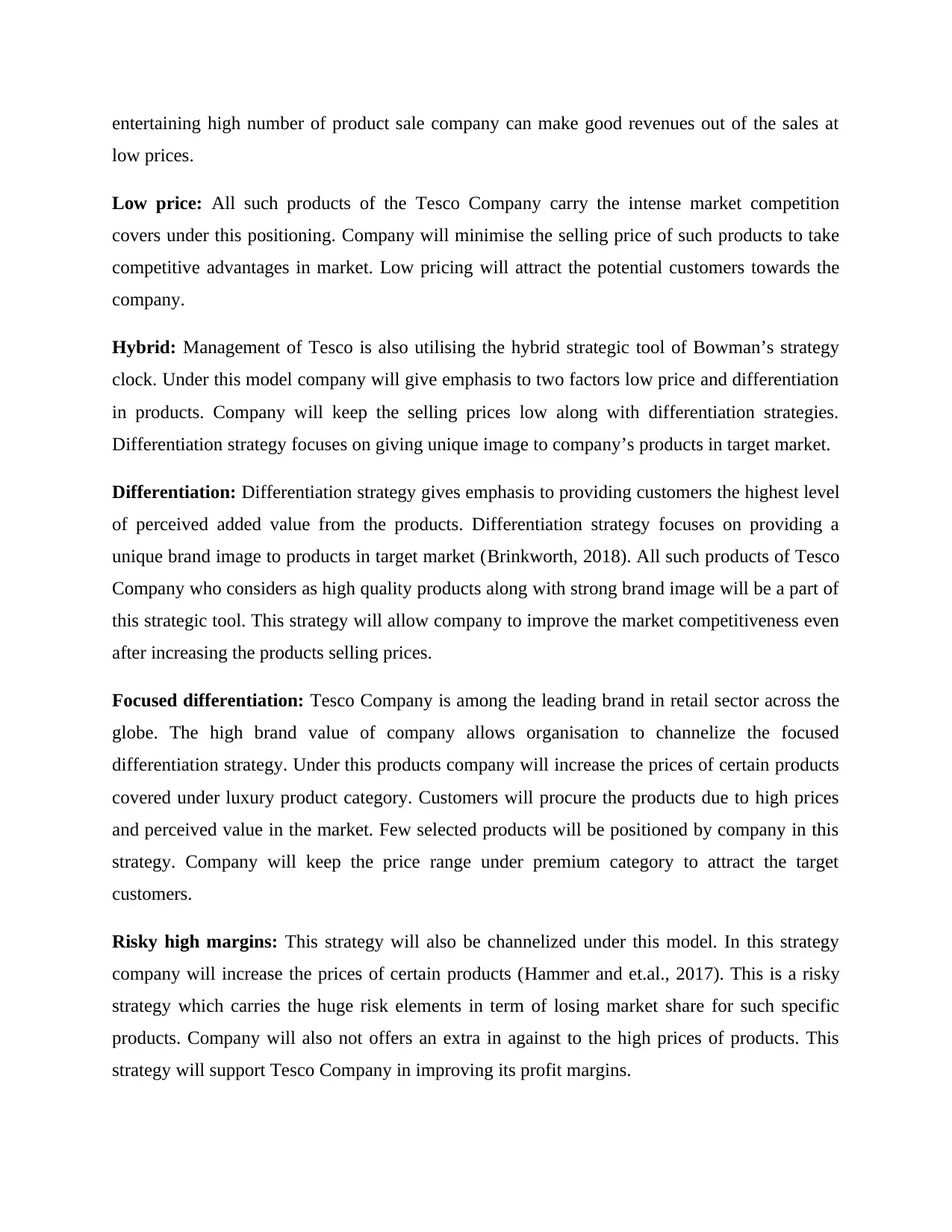
entertaining high number of product sale company can make good revenues out of the sales at
low prices.
Low price: All such products of the Tesco Company carry the intense market competition
covers under this positioning. Company will minimise the selling price of such products to take
competitive advantages in market. Low pricing will attract the potential customers towards the
company.
Hybrid: Management of Tesco is also utilising the hybrid strategic tool of Bowman’s strategy
clock. Under this model company will give emphasis to two factors low price and differentiation
in products. Company will keep the selling prices low along with differentiation strategies.
Differentiation strategy focuses on giving unique image to company’s products in target market.
Differentiation: Differentiation strategy gives emphasis to providing customers the highest level
of perceived added value from the products. Differentiation strategy focuses on providing a
unique brand image to products in target market (Brinkworth, 2018). All such products of Tesco
Company who considers as high quality products along with strong brand image will be a part of
this strategic tool. This strategy will allow company to improve the market competitiveness even
after increasing the products selling prices.
Focused differentiation: Tesco Company is among the leading brand in retail sector across the
globe. The high brand value of company allows organisation to channelize the focused
differentiation strategy. Under this products company will increase the prices of certain products
covered under luxury product category. Customers will procure the products due to high prices
and perceived value in the market. Few selected products will be positioned by company in this
strategy. Company will keep the price range under premium category to attract the target
customers.
Risky high margins: This strategy will also be channelized under this model. In this strategy
company will increase the prices of certain products (Hammer and et.al., 2017). This is a risky
strategy which carries the huge risk elements in term of losing market share for such specific
products. Company will also not offers an extra in against to the high prices of products. This
strategy will support Tesco Company in improving its profit margins.
low prices.
Low price: All such products of the Tesco Company carry the intense market competition
covers under this positioning. Company will minimise the selling price of such products to take
competitive advantages in market. Low pricing will attract the potential customers towards the
company.
Hybrid: Management of Tesco is also utilising the hybrid strategic tool of Bowman’s strategy
clock. Under this model company will give emphasis to two factors low price and differentiation
in products. Company will keep the selling prices low along with differentiation strategies.
Differentiation strategy focuses on giving unique image to company’s products in target market.
Differentiation: Differentiation strategy gives emphasis to providing customers the highest level
of perceived added value from the products. Differentiation strategy focuses on providing a
unique brand image to products in target market (Brinkworth, 2018). All such products of Tesco
Company who considers as high quality products along with strong brand image will be a part of
this strategic tool. This strategy will allow company to improve the market competitiveness even
after increasing the products selling prices.
Focused differentiation: Tesco Company is among the leading brand in retail sector across the
globe. The high brand value of company allows organisation to channelize the focused
differentiation strategy. Under this products company will increase the prices of certain products
covered under luxury product category. Customers will procure the products due to high prices
and perceived value in the market. Few selected products will be positioned by company in this
strategy. Company will keep the price range under premium category to attract the target
customers.
Risky high margins: This strategy will also be channelized under this model. In this strategy
company will increase the prices of certain products (Hammer and et.al., 2017). This is a risky
strategy which carries the huge risk elements in term of losing market share for such specific
products. Company will also not offers an extra in against to the high prices of products. This
strategy will support Tesco Company in improving its profit margins.
Secure Best Marks with AI Grader
Need help grading? Try our AI Grader for instant feedback on your assignments.
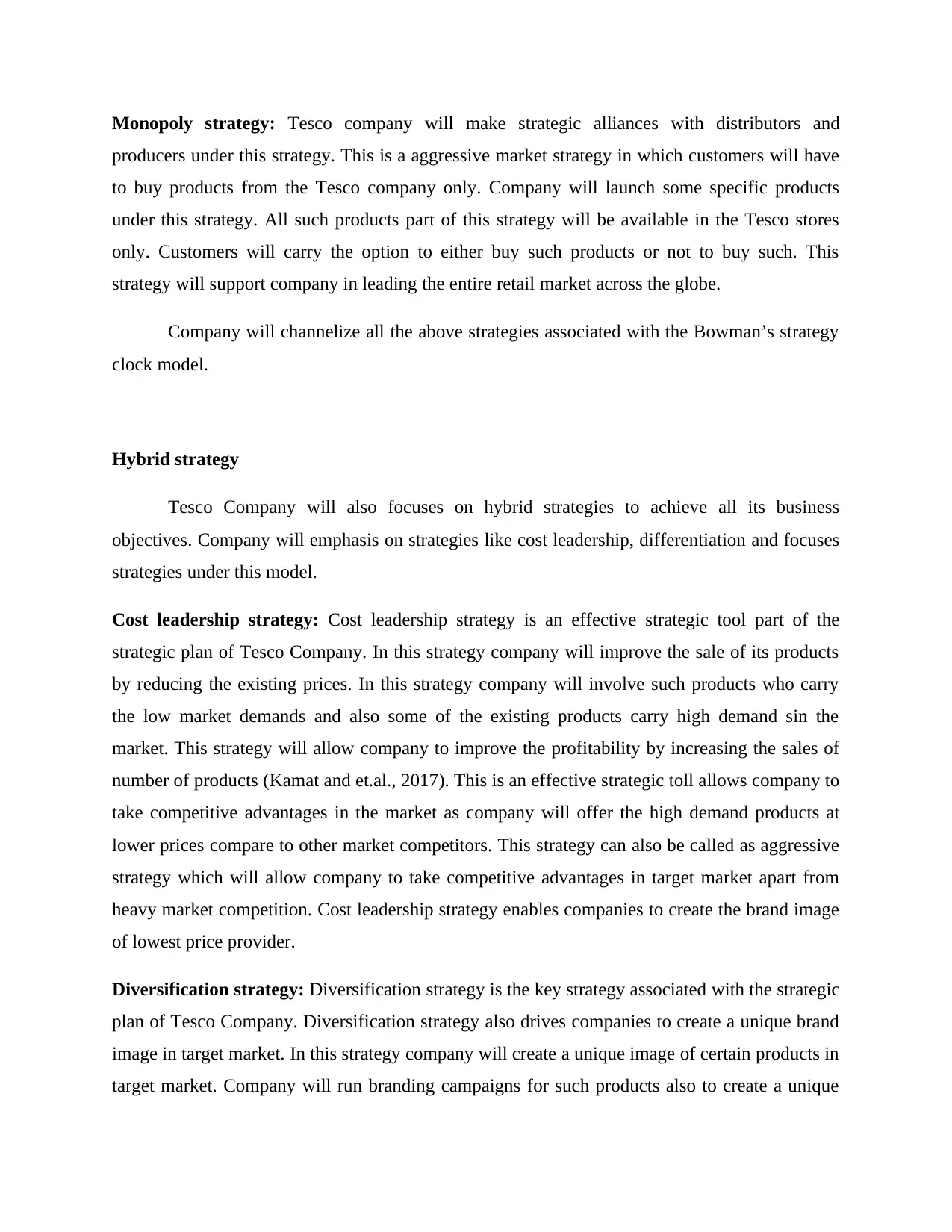
Monopoly strategy: Tesco company will make strategic alliances with distributors and
producers under this strategy. This is a aggressive market strategy in which customers will have
to buy products from the Tesco company only. Company will launch some specific products
under this strategy. All such products part of this strategy will be available in the Tesco stores
only. Customers will carry the option to either buy such products or not to buy such. This
strategy will support company in leading the entire retail market across the globe.
Company will channelize all the above strategies associated with the Bowman’s strategy
clock model.
Hybrid strategy
Tesco Company will also focuses on hybrid strategies to achieve all its business
objectives. Company will emphasis on strategies like cost leadership, differentiation and focuses
strategies under this model.
Cost leadership strategy: Cost leadership strategy is an effective strategic tool part of the
strategic plan of Tesco Company. In this strategy company will improve the sale of its products
by reducing the existing prices. In this strategy company will involve such products who carry
the low market demands and also some of the existing products carry high demand sin the
market. This strategy will allow company to improve the profitability by increasing the sales of
number of products (Kamat and et.al., 2017). This is an effective strategic toll allows company to
take competitive advantages in the market as company will offer the high demand products at
lower prices compare to other market competitors. This strategy can also be called as aggressive
strategy which will allow company to take competitive advantages in target market apart from
heavy market competition. Cost leadership strategy enables companies to create the brand image
of lowest price provider.
Diversification strategy: Diversification strategy is the key strategy associated with the strategic
plan of Tesco Company. Diversification strategy also drives companies to create a unique brand
image in target market. In this strategy company will create a unique image of certain products in
target market. Company will run branding campaigns for such products also to create a unique
producers under this strategy. This is a aggressive market strategy in which customers will have
to buy products from the Tesco company only. Company will launch some specific products
under this strategy. All such products part of this strategy will be available in the Tesco stores
only. Customers will carry the option to either buy such products or not to buy such. This
strategy will support company in leading the entire retail market across the globe.
Company will channelize all the above strategies associated with the Bowman’s strategy
clock model.
Hybrid strategy
Tesco Company will also focuses on hybrid strategies to achieve all its business
objectives. Company will emphasis on strategies like cost leadership, differentiation and focuses
strategies under this model.
Cost leadership strategy: Cost leadership strategy is an effective strategic tool part of the
strategic plan of Tesco Company. In this strategy company will improve the sale of its products
by reducing the existing prices. In this strategy company will involve such products who carry
the low market demands and also some of the existing products carry high demand sin the
market. This strategy will allow company to improve the profitability by increasing the sales of
number of products (Kamat and et.al., 2017). This is an effective strategic toll allows company to
take competitive advantages in the market as company will offer the high demand products at
lower prices compare to other market competitors. This strategy can also be called as aggressive
strategy which will allow company to take competitive advantages in target market apart from
heavy market competition. Cost leadership strategy enables companies to create the brand image
of lowest price provider.
Diversification strategy: Diversification strategy is the key strategy associated with the strategic
plan of Tesco Company. Diversification strategy also drives companies to create a unique brand
image in target market. In this strategy company will create a unique image of certain products in
target market. Company will run branding campaigns for such products also to create a unique
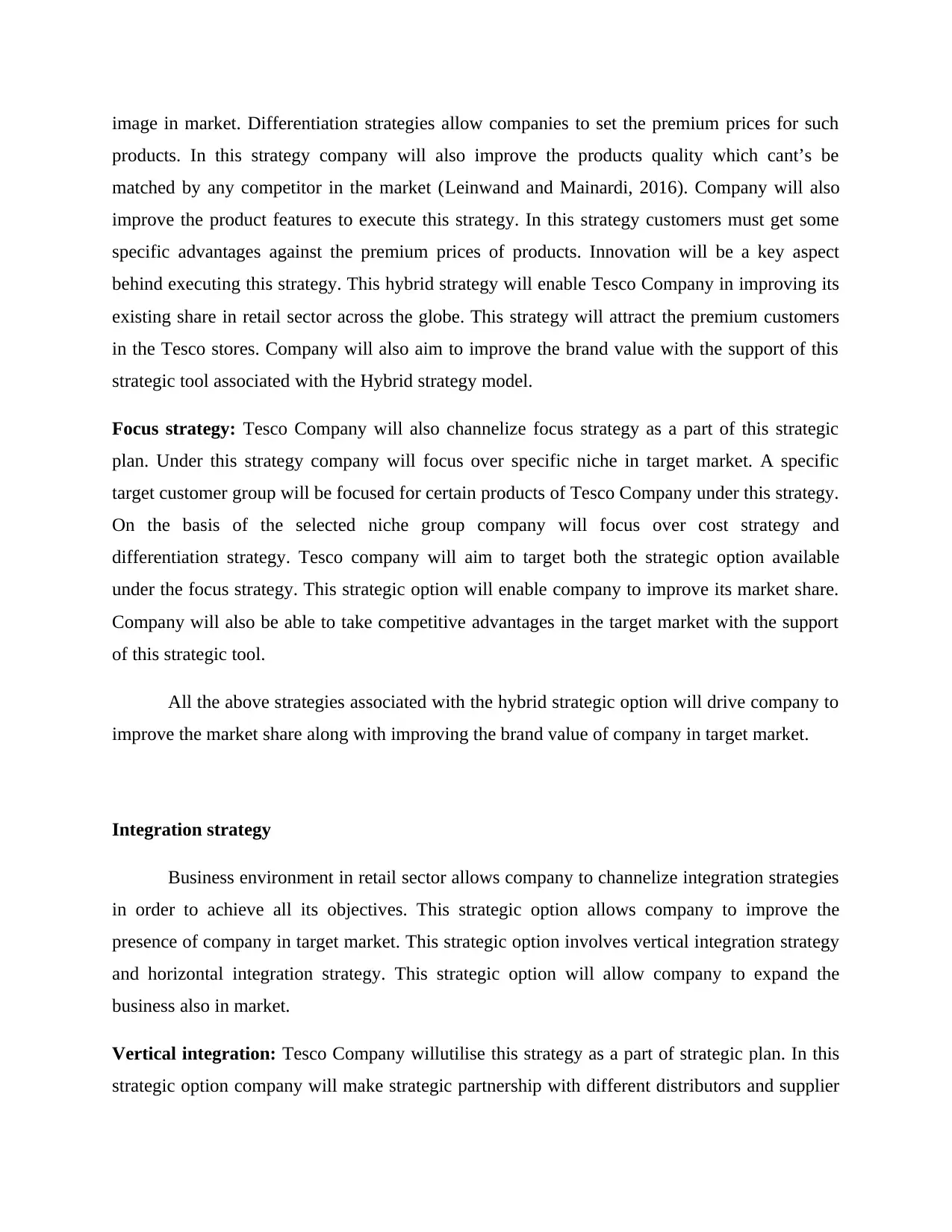
image in market. Differentiation strategies allow companies to set the premium prices for such
products. In this strategy company will also improve the products quality which cant’s be
matched by any competitor in the market (Leinwand and Mainardi, 2016). Company will also
improve the product features to execute this strategy. In this strategy customers must get some
specific advantages against the premium prices of products. Innovation will be a key aspect
behind executing this strategy. This hybrid strategy will enable Tesco Company in improving its
existing share in retail sector across the globe. This strategy will attract the premium customers
in the Tesco stores. Company will also aim to improve the brand value with the support of this
strategic tool associated with the Hybrid strategy model.
Focus strategy: Tesco Company will also channelize focus strategy as a part of this strategic
plan. Under this strategy company will focus over specific niche in target market. A specific
target customer group will be focused for certain products of Tesco Company under this strategy.
On the basis of the selected niche group company will focus over cost strategy and
differentiation strategy. Tesco company will aim to target both the strategic option available
under the focus strategy. This strategic option will enable company to improve its market share.
Company will also be able to take competitive advantages in the target market with the support
of this strategic tool.
All the above strategies associated with the hybrid strategic option will drive company to
improve the market share along with improving the brand value of company in target market.
Integration strategy
Business environment in retail sector allows company to channelize integration strategies
in order to achieve all its objectives. This strategic option allows company to improve the
presence of company in target market. This strategic option involves vertical integration strategy
and horizontal integration strategy. This strategic option will allow company to expand the
business also in market.
Vertical integration: Tesco Company willutilise this strategy as a part of strategic plan. In this
strategic option company will make strategic partnership with different distributors and supplier
products. In this strategy company will also improve the products quality which cant’s be
matched by any competitor in the market (Leinwand and Mainardi, 2016). Company will also
improve the product features to execute this strategy. In this strategy customers must get some
specific advantages against the premium prices of products. Innovation will be a key aspect
behind executing this strategy. This hybrid strategy will enable Tesco Company in improving its
existing share in retail sector across the globe. This strategy will attract the premium customers
in the Tesco stores. Company will also aim to improve the brand value with the support of this
strategic tool associated with the Hybrid strategy model.
Focus strategy: Tesco Company will also channelize focus strategy as a part of this strategic
plan. Under this strategy company will focus over specific niche in target market. A specific
target customer group will be focused for certain products of Tesco Company under this strategy.
On the basis of the selected niche group company will focus over cost strategy and
differentiation strategy. Tesco company will aim to target both the strategic option available
under the focus strategy. This strategic option will enable company to improve its market share.
Company will also be able to take competitive advantages in the target market with the support
of this strategic tool.
All the above strategies associated with the hybrid strategic option will drive company to
improve the market share along with improving the brand value of company in target market.
Integration strategy
Business environment in retail sector allows company to channelize integration strategies
in order to achieve all its objectives. This strategic option allows company to improve the
presence of company in target market. This strategic option involves vertical integration strategy
and horizontal integration strategy. This strategic option will allow company to expand the
business also in market.
Vertical integration: Tesco Company willutilise this strategy as a part of strategic plan. In this
strategic option company will make strategic partnership with different distributors and supplier
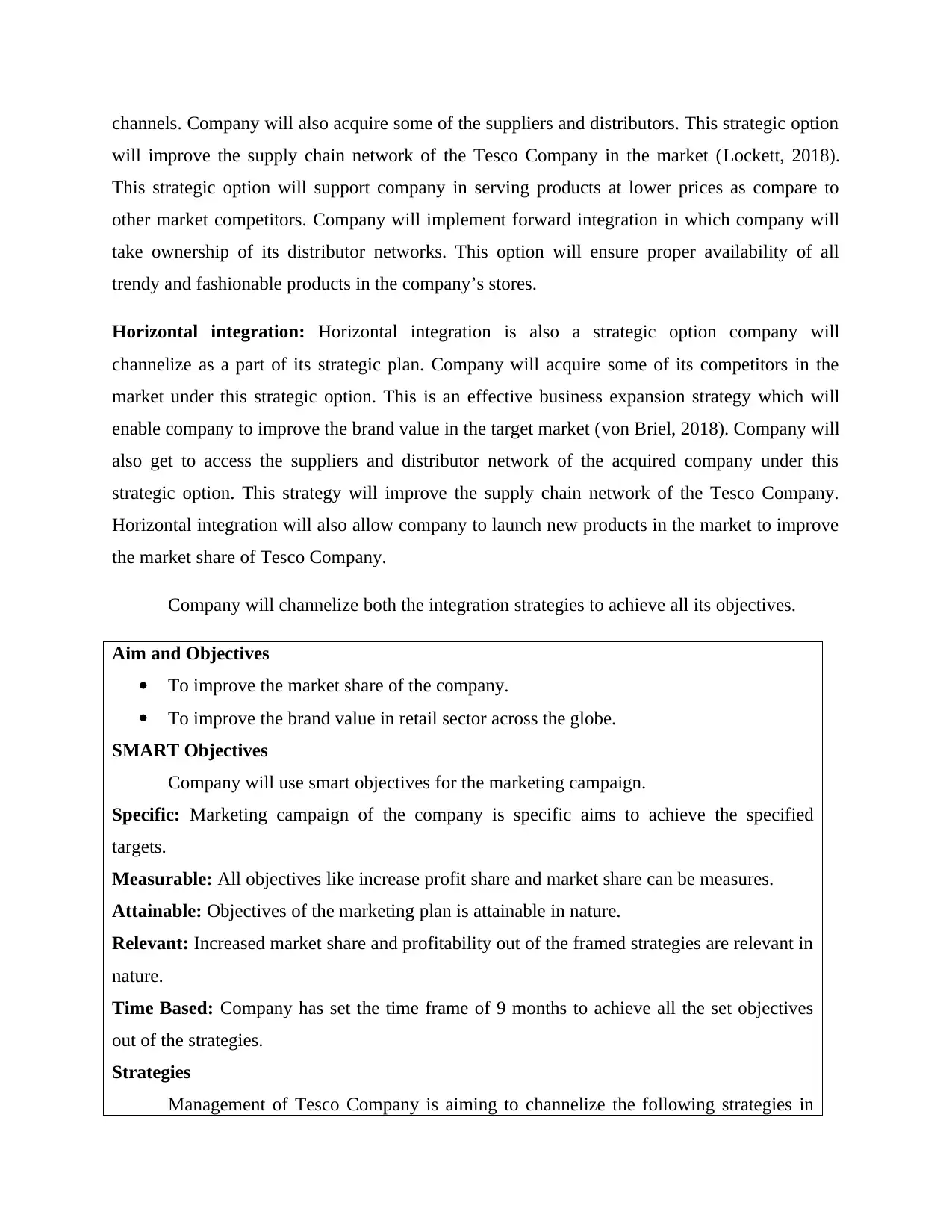
channels. Company will also acquire some of the suppliers and distributors. This strategic option
will improve the supply chain network of the Tesco Company in the market (Lockett, 2018).
This strategic option will support company in serving products at lower prices as compare to
other market competitors. Company will implement forward integration in which company will
take ownership of its distributor networks. This option will ensure proper availability of all
trendy and fashionable products in the company’s stores.
Horizontal integration: Horizontal integration is also a strategic option company will
channelize as a part of its strategic plan. Company will acquire some of its competitors in the
market under this strategic option. This is an effective business expansion strategy which will
enable company to improve the brand value in the target market (von Briel, 2018). Company will
also get to access the suppliers and distributor network of the acquired company under this
strategic option. This strategy will improve the supply chain network of the Tesco Company.
Horizontal integration will also allow company to launch new products in the market to improve
the market share of Tesco Company.
Company will channelize both the integration strategies to achieve all its objectives.
Aim and Objectives
To improve the market share of the company.
To improve the brand value in retail sector across the globe.
SMART Objectives
Company will use smart objectives for the marketing campaign.
Specific: Marketing campaign of the company is specific aims to achieve the specified
targets.
Measurable: All objectives like increase profit share and market share can be measures.
Attainable: Objectives of the marketing plan is attainable in nature.
Relevant: Increased market share and profitability out of the framed strategies are relevant in
nature.
Time Based: Company has set the time frame of 9 months to achieve all the set objectives
out of the strategies.
Strategies
Management of Tesco Company is aiming to channelize the following strategies in
will improve the supply chain network of the Tesco Company in the market (Lockett, 2018).
This strategic option will support company in serving products at lower prices as compare to
other market competitors. Company will implement forward integration in which company will
take ownership of its distributor networks. This option will ensure proper availability of all
trendy and fashionable products in the company’s stores.
Horizontal integration: Horizontal integration is also a strategic option company will
channelize as a part of its strategic plan. Company will acquire some of its competitors in the
market under this strategic option. This is an effective business expansion strategy which will
enable company to improve the brand value in the target market (von Briel, 2018). Company will
also get to access the suppliers and distributor network of the acquired company under this
strategic option. This strategy will improve the supply chain network of the Tesco Company.
Horizontal integration will also allow company to launch new products in the market to improve
the market share of Tesco Company.
Company will channelize both the integration strategies to achieve all its objectives.
Aim and Objectives
To improve the market share of the company.
To improve the brand value in retail sector across the globe.
SMART Objectives
Company will use smart objectives for the marketing campaign.
Specific: Marketing campaign of the company is specific aims to achieve the specified
targets.
Measurable: All objectives like increase profit share and market share can be measures.
Attainable: Objectives of the marketing plan is attainable in nature.
Relevant: Increased market share and profitability out of the framed strategies are relevant in
nature.
Time Based: Company has set the time frame of 9 months to achieve all the set objectives
out of the strategies.
Strategies
Management of Tesco Company is aiming to channelize the following strategies in
Paraphrase This Document
Need a fresh take? Get an instant paraphrase of this document with our AI Paraphraser
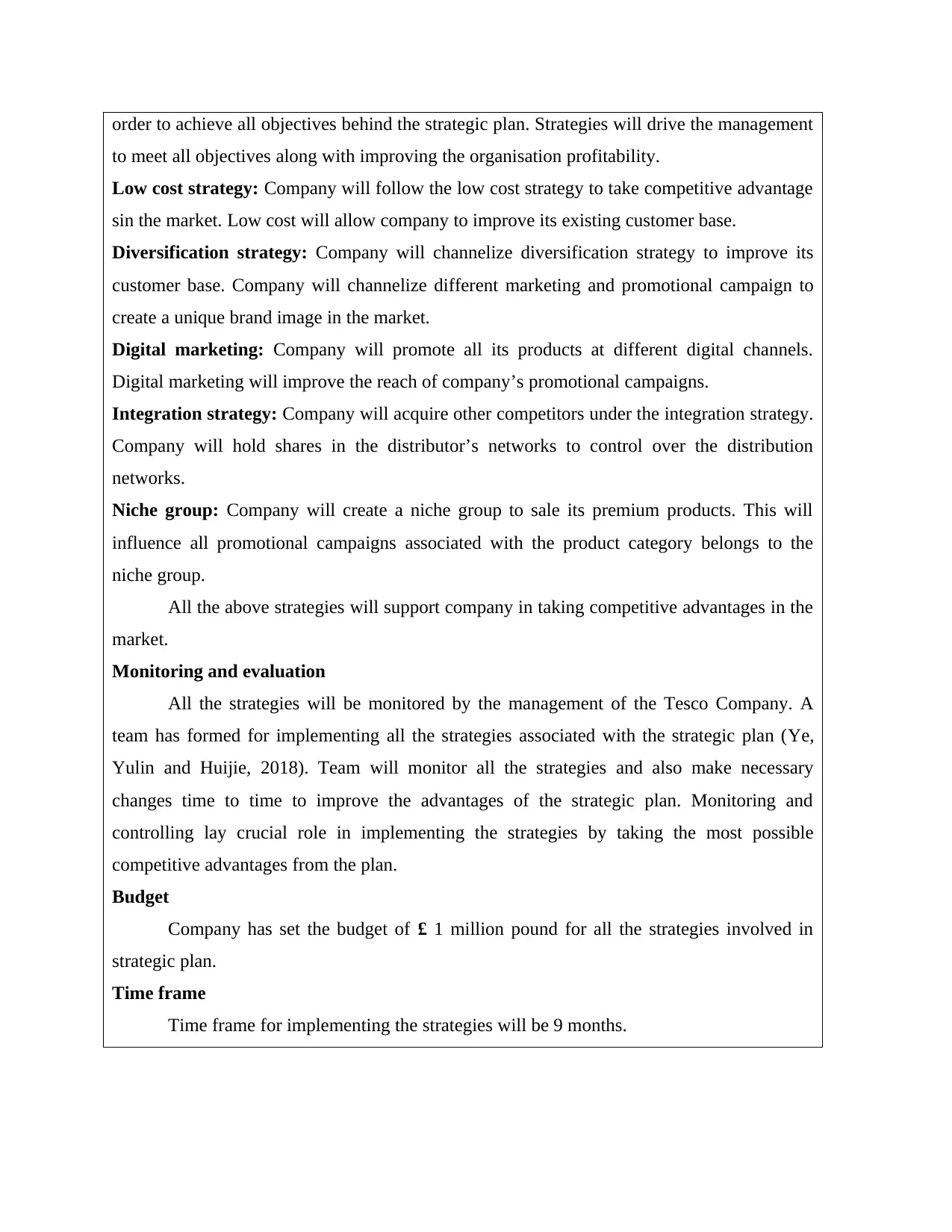
order to achieve all objectives behind the strategic plan. Strategies will drive the management
to meet all objectives along with improving the organisation profitability.
Low cost strategy: Company will follow the low cost strategy to take competitive advantage
sin the market. Low cost will allow company to improve its existing customer base.
Diversification strategy: Company will channelize diversification strategy to improve its
customer base. Company will channelize different marketing and promotional campaign to
create a unique brand image in the market.
Digital marketing: Company will promote all its products at different digital channels.
Digital marketing will improve the reach of company’s promotional campaigns.
Integration strategy: Company will acquire other competitors under the integration strategy.
Company will hold shares in the distributor’s networks to control over the distribution
networks.
Niche group: Company will create a niche group to sale its premium products. This will
influence all promotional campaigns associated with the product category belongs to the
niche group.
All the above strategies will support company in taking competitive advantages in the
market.
Monitoring and evaluation
All the strategies will be monitored by the management of the Tesco Company. A
team has formed for implementing all the strategies associated with the strategic plan (Ye,
Yulin and Huijie, 2018). Team will monitor all the strategies and also make necessary
changes time to time to improve the advantages of the strategic plan. Monitoring and
controlling lay crucial role in implementing the strategies by taking the most possible
competitive advantages from the plan.
Budget
Company has set the budget of £ 1 million pound for all the strategies involved in
strategic plan.
Time frame
Time frame for implementing the strategies will be 9 months.
to meet all objectives along with improving the organisation profitability.
Low cost strategy: Company will follow the low cost strategy to take competitive advantage
sin the market. Low cost will allow company to improve its existing customer base.
Diversification strategy: Company will channelize diversification strategy to improve its
customer base. Company will channelize different marketing and promotional campaign to
create a unique brand image in the market.
Digital marketing: Company will promote all its products at different digital channels.
Digital marketing will improve the reach of company’s promotional campaigns.
Integration strategy: Company will acquire other competitors under the integration strategy.
Company will hold shares in the distributor’s networks to control over the distribution
networks.
Niche group: Company will create a niche group to sale its premium products. This will
influence all promotional campaigns associated with the product category belongs to the
niche group.
All the above strategies will support company in taking competitive advantages in the
market.
Monitoring and evaluation
All the strategies will be monitored by the management of the Tesco Company. A
team has formed for implementing all the strategies associated with the strategic plan (Ye,
Yulin and Huijie, 2018). Team will monitor all the strategies and also make necessary
changes time to time to improve the advantages of the strategic plan. Monitoring and
controlling lay crucial role in implementing the strategies by taking the most possible
competitive advantages from the plan.
Budget
Company has set the budget of £ 1 million pound for all the strategies involved in
strategic plan.
Time frame
Time frame for implementing the strategies will be 9 months.
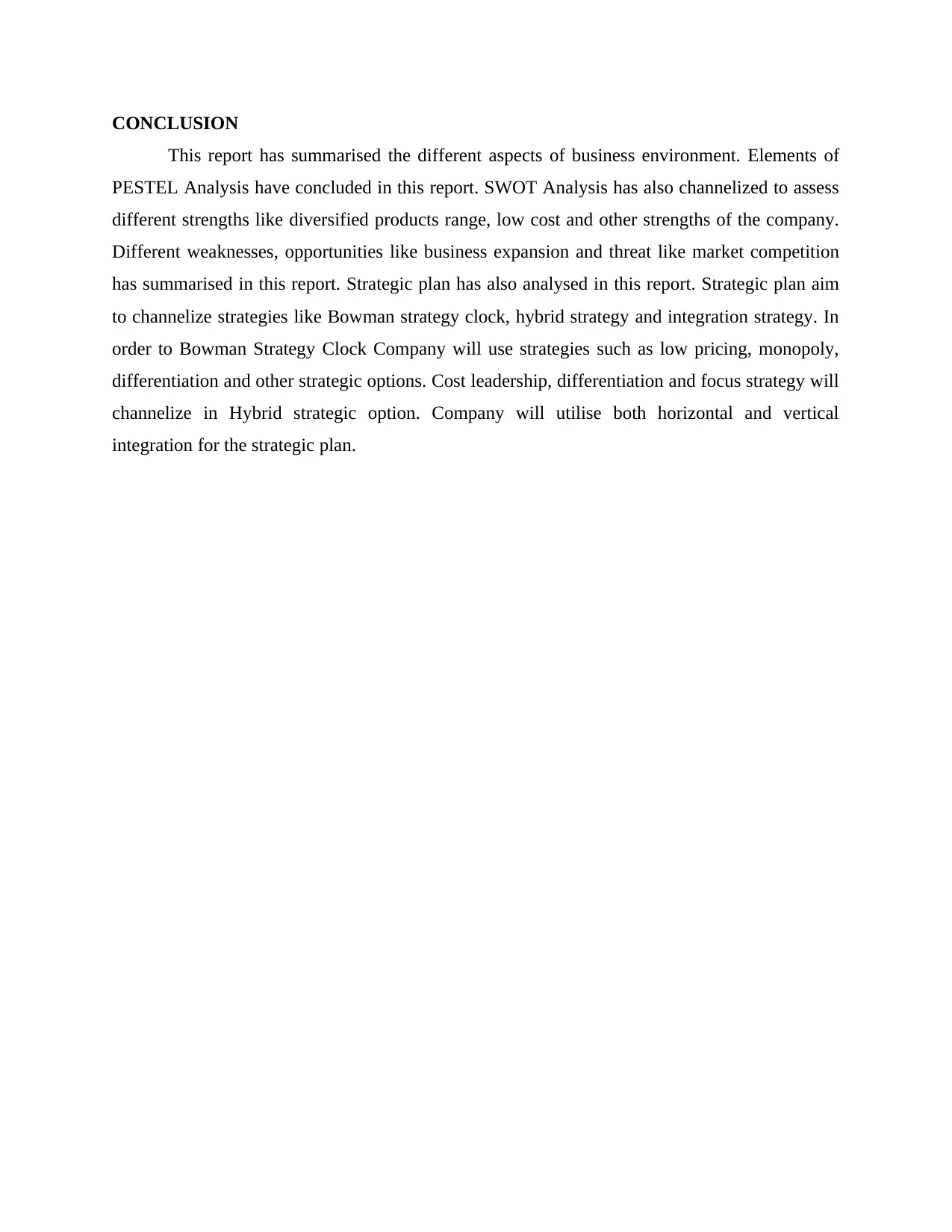
CONCLUSION
This report has summarised the different aspects of business environment. Elements of
PESTEL Analysis have concluded in this report. SWOT Analysis has also channelized to assess
different strengths like diversified products range, low cost and other strengths of the company.
Different weaknesses, opportunities like business expansion and threat like market competition
has summarised in this report. Strategic plan has also analysed in this report. Strategic plan aim
to channelize strategies like Bowman strategy clock, hybrid strategy and integration strategy. In
order to Bowman Strategy Clock Company will use strategies such as low pricing, monopoly,
differentiation and other strategic options. Cost leadership, differentiation and focus strategy will
channelize in Hybrid strategic option. Company will utilise both horizontal and vertical
integration for the strategic plan.
This report has summarised the different aspects of business environment. Elements of
PESTEL Analysis have concluded in this report. SWOT Analysis has also channelized to assess
different strengths like diversified products range, low cost and other strengths of the company.
Different weaknesses, opportunities like business expansion and threat like market competition
has summarised in this report. Strategic plan has also analysed in this report. Strategic plan aim
to channelize strategies like Bowman strategy clock, hybrid strategy and integration strategy. In
order to Bowman Strategy Clock Company will use strategies such as low pricing, monopoly,
differentiation and other strategic options. Cost leadership, differentiation and focus strategy will
channelize in Hybrid strategic option. Company will utilise both horizontal and vertical
integration for the strategic plan.
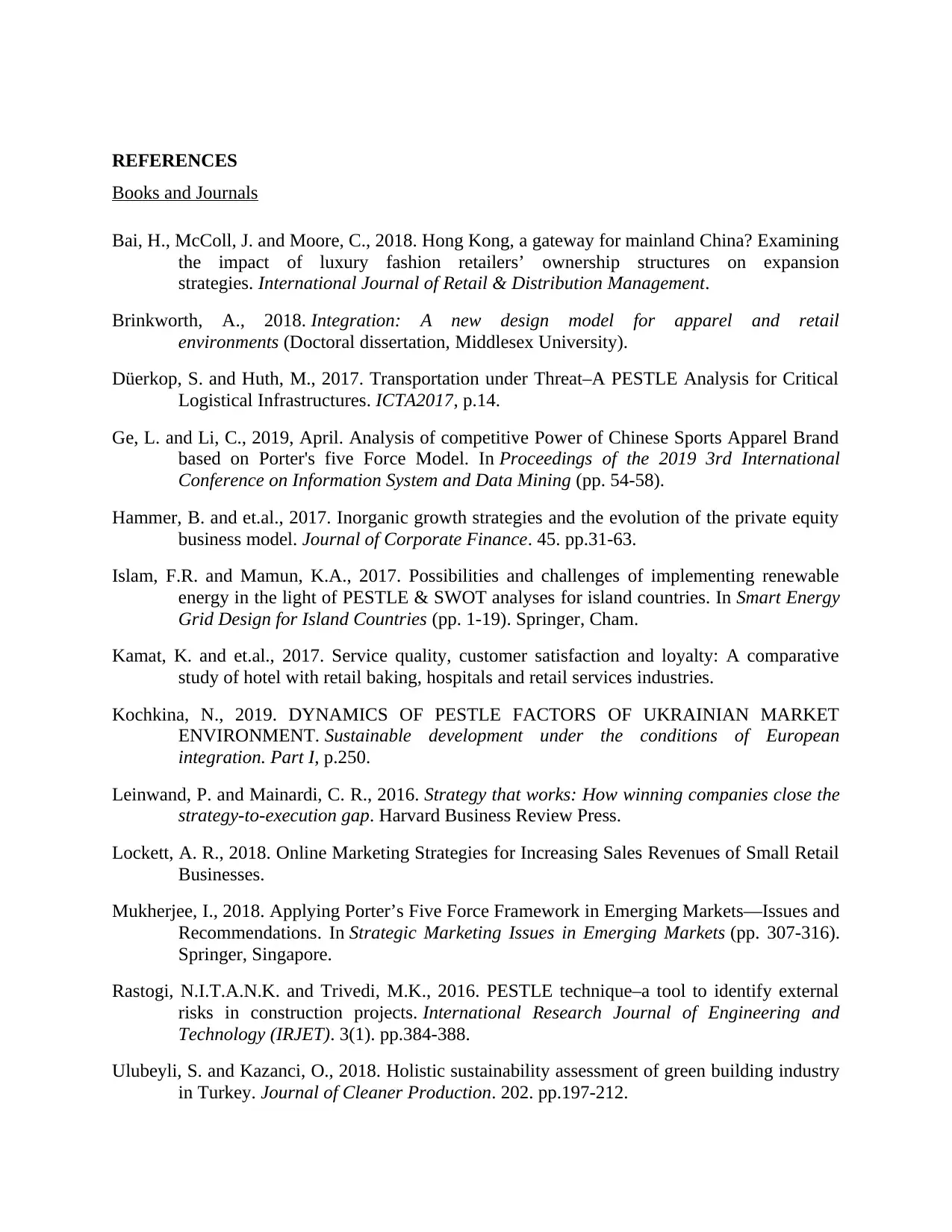
REFERENCES
Books and Journals
Bai, H., McColl, J. and Moore, C., 2018. Hong Kong, a gateway for mainland China? Examining
the impact of luxury fashion retailers’ ownership structures on expansion
strategies. International Journal of Retail & Distribution Management.
Brinkworth, A., 2018. Integration: A new design model for apparel and retail
environments (Doctoral dissertation, Middlesex University).
Düerkop, S. and Huth, M., 2017. Transportation under Threat–A PESTLE Analysis for Critical
Logistical Infrastructures. ICTA2017, p.14.
Ge, L. and Li, C., 2019, April. Analysis of competitive Power of Chinese Sports Apparel Brand
based on Porter's five Force Model. In Proceedings of the 2019 3rd International
Conference on Information System and Data Mining (pp. 54-58).
Hammer, B. and et.al., 2017. Inorganic growth strategies and the evolution of the private equity
business model. Journal of Corporate Finance. 45. pp.31-63.
Islam, F.R. and Mamun, K.A., 2017. Possibilities and challenges of implementing renewable
energy in the light of PESTLE & SWOT analyses for island countries. In Smart Energy
Grid Design for Island Countries (pp. 1-19). Springer, Cham.
Kamat, K. and et.al., 2017. Service quality, customer satisfaction and loyalty: A comparative
study of hotel with retail baking, hospitals and retail services industries.
Kochkina, N., 2019. DYNAMICS OF PESTLE FACTORS OF UKRAINIAN MARKET
ENVIRONMENT. Sustainable development under the conditions of European
integration. Part I, p.250.
Leinwand, P. and Mainardi, C. R., 2016. Strategy that works: How winning companies close the
strategy-to-execution gap. Harvard Business Review Press.
Lockett, A. R., 2018. Online Marketing Strategies for Increasing Sales Revenues of Small Retail
Businesses.
Mukherjee, I., 2018. Applying Porter’s Five Force Framework in Emerging Markets—Issues and
Recommendations. In Strategic Marketing Issues in Emerging Markets (pp. 307-316).
Springer, Singapore.
Rastogi, N.I.T.A.N.K. and Trivedi, M.K., 2016. PESTLE technique–a tool to identify external
risks in construction projects. International Research Journal of Engineering and
Technology (IRJET). 3(1). pp.384-388.
Ulubeyli, S. and Kazanci, O., 2018. Holistic sustainability assessment of green building industry
in Turkey. Journal of Cleaner Production. 202. pp.197-212.
Books and Journals
Bai, H., McColl, J. and Moore, C., 2018. Hong Kong, a gateway for mainland China? Examining
the impact of luxury fashion retailers’ ownership structures on expansion
strategies. International Journal of Retail & Distribution Management.
Brinkworth, A., 2018. Integration: A new design model for apparel and retail
environments (Doctoral dissertation, Middlesex University).
Düerkop, S. and Huth, M., 2017. Transportation under Threat–A PESTLE Analysis for Critical
Logistical Infrastructures. ICTA2017, p.14.
Ge, L. and Li, C., 2019, April. Analysis of competitive Power of Chinese Sports Apparel Brand
based on Porter's five Force Model. In Proceedings of the 2019 3rd International
Conference on Information System and Data Mining (pp. 54-58).
Hammer, B. and et.al., 2017. Inorganic growth strategies and the evolution of the private equity
business model. Journal of Corporate Finance. 45. pp.31-63.
Islam, F.R. and Mamun, K.A., 2017. Possibilities and challenges of implementing renewable
energy in the light of PESTLE & SWOT analyses for island countries. In Smart Energy
Grid Design for Island Countries (pp. 1-19). Springer, Cham.
Kamat, K. and et.al., 2017. Service quality, customer satisfaction and loyalty: A comparative
study of hotel with retail baking, hospitals and retail services industries.
Kochkina, N., 2019. DYNAMICS OF PESTLE FACTORS OF UKRAINIAN MARKET
ENVIRONMENT. Sustainable development under the conditions of European
integration. Part I, p.250.
Leinwand, P. and Mainardi, C. R., 2016. Strategy that works: How winning companies close the
strategy-to-execution gap. Harvard Business Review Press.
Lockett, A. R., 2018. Online Marketing Strategies for Increasing Sales Revenues of Small Retail
Businesses.
Mukherjee, I., 2018. Applying Porter’s Five Force Framework in Emerging Markets—Issues and
Recommendations. In Strategic Marketing Issues in Emerging Markets (pp. 307-316).
Springer, Singapore.
Rastogi, N.I.T.A.N.K. and Trivedi, M.K., 2016. PESTLE technique–a tool to identify external
risks in construction projects. International Research Journal of Engineering and
Technology (IRJET). 3(1). pp.384-388.
Ulubeyli, S. and Kazanci, O., 2018. Holistic sustainability assessment of green building industry
in Turkey. Journal of Cleaner Production. 202. pp.197-212.
Secure Best Marks with AI Grader
Need help grading? Try our AI Grader for instant feedback on your assignments.
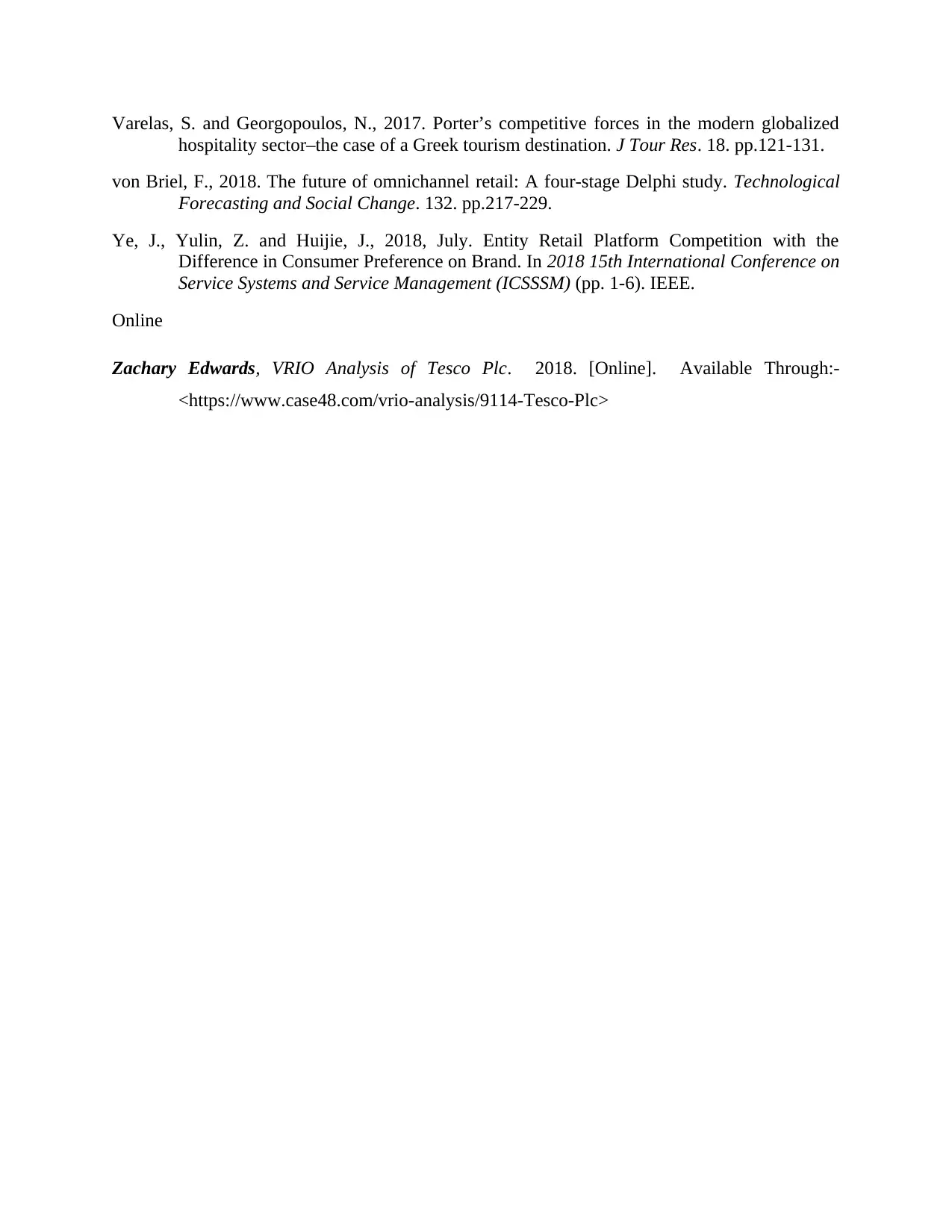
Varelas, S. and Georgopoulos, N., 2017. Porter’s competitive forces in the modern globalized
hospitality sector–the case of a Greek tourism destination. J Tour Res. 18. pp.121-131.
von Briel, F., 2018. The future of omnichannel retail: A four-stage Delphi study. Technological
Forecasting and Social Change. 132. pp.217-229.
Ye, J., Yulin, Z. and Huijie, J., 2018, July. Entity Retail Platform Competition with the
Difference in Consumer Preference on Brand. In 2018 15th International Conference on
Service Systems and Service Management (ICSSSM) (pp. 1-6). IEEE.
Online
Zachary Edwards, VRIO Analysis of Tesco Plc. 2018. [Online]. Available Through:-
<https://www.case48.com/vrio-analysis/9114-Tesco-Plc>
hospitality sector–the case of a Greek tourism destination. J Tour Res. 18. pp.121-131.
von Briel, F., 2018. The future of omnichannel retail: A four-stage Delphi study. Technological
Forecasting and Social Change. 132. pp.217-229.
Ye, J., Yulin, Z. and Huijie, J., 2018, July. Entity Retail Platform Competition with the
Difference in Consumer Preference on Brand. In 2018 15th International Conference on
Service Systems and Service Management (ICSSSM) (pp. 1-6). IEEE.
Online
Zachary Edwards, VRIO Analysis of Tesco Plc. 2018. [Online]. Available Through:-
<https://www.case48.com/vrio-analysis/9114-Tesco-Plc>
1 out of 17
Related Documents
Your All-in-One AI-Powered Toolkit for Academic Success.
+13062052269
info@desklib.com
Available 24*7 on WhatsApp / Email
![[object Object]](/_next/static/media/star-bottom.7253800d.svg)
Unlock your academic potential
© 2024 | Zucol Services PVT LTD | All rights reserved.


